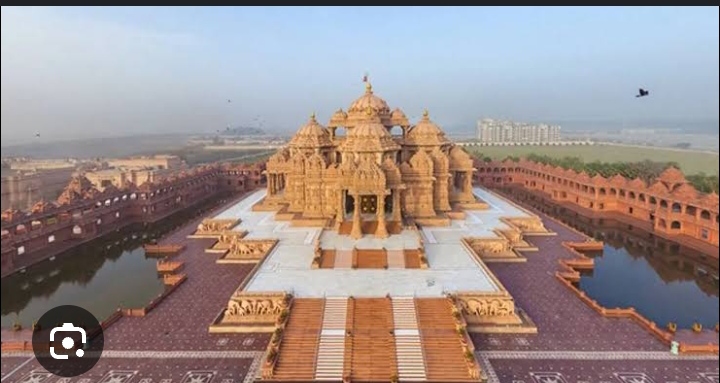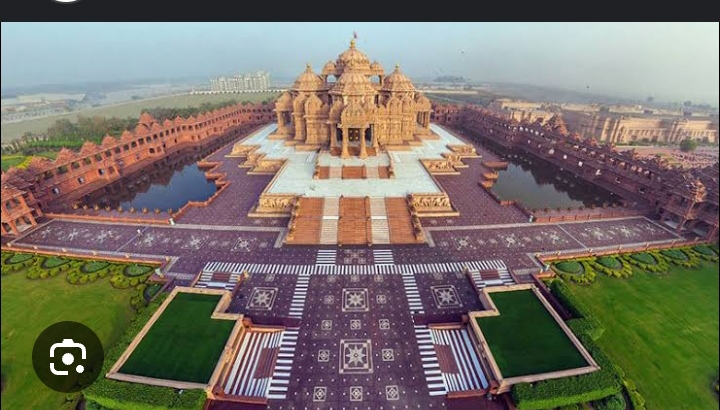
Nestled amidst the bustling city of Delhi, the Akshardham Temple stands as a testament to timeless artistry and spiritual magnificence. With its roots deeply embedded in history, chronicled beautifully by Singh in “Temple of eternal return,” and analyzed with scholarly depth by Mehta in “Art and Architectural study of Swaminarayan Akshardham Temple,” this architectural marvel has woven itself into the fabric of local life. Kim’s exploration in “Thinking through Akshardham” illuminates the profound significance of this temple, not just as a place of worship but as a cornerstone of Swaminarayan identity. Let’s embark on a journey to discover the soul-stirring history and cherished prominence of Akshardham Temple, where every stone tells a story and every carving whispers ancient wisdom.

History of Akshardham Temple
The history of Akshardham Temple is a captivating tale that intertwines spirituality, artistry, and cultural significance. Its genesis can be traced back to the vision of Pramukh Swami Maharaj, the fifth spiritual successor of Bhagwan Swaminarayan, who envisioned a grand temple to honor their teachings and legacy.
In the scholarly work of Singh, “Temple of eternal return,” we delve into the origins of this magnificent complex. The Swaminarayan Akshardham complex in Delhi was inaugurated on November 6, 2005, after years of meticulous planning and construction. Its name, “Akshardham,” translates to the divine abode of God, embodying the essence of purity and spirituality.
The temple complex is not merely a structure of stone and marble; it is a living embodiment of Indian culture and heritage. Mehta’s research, “Art and Architectural study of Swaminarayan Akshardham Temple,” sheds light on the intricate artistry that adorns every inch of the temple. From the stunning carvings depicting stories from Indian epics like the Ramayana and Mahabharata to the exquisite architecture that echoes ancient Vedic principles, each element is a testament to the devotion and craftsmanship of thousands of artisans.
The temple’s main monument, the Akshardham Mandir, stands tall as the focal point of the complex. Its construction employed traditional Vedic architectural techniques, blending pink sandstone with white marble to create a breathtaking sight. The Mandir’s central deity is Lord Swaminarayan, revered as a manifestation of the Supreme Being according to the Swaminarayan faith.
However, the history of Akshardham Temple extends beyond its physical structure. It embodies the resilience and spirit of the Swaminarayan faith. Kim’s work, “Thinking through Akshardham and the making of the Swaminarayan self,” explores how the temple serves not just as a place of worship but as a unifying force for the Swaminarayan community. It symbolizes their identity, values, and unwavering devotion to Bhagwan Swaminarayan.
The temple’s history is not without challenges. In 2006, it faced a tragic terrorist attack, a stark reminder of the turbulent times we live in. However, this adversity only strengthened the resolve of the devotees and the temple’s significance in promoting peace and harmony.
Today, Akshardham Temple stands not just as a religious landmark but as a cultural oasis in the heart of Delhi. Its sprawling complex includes exhibitions, gardens, and a musical fountain show, attracting millions of visitors annually. It continues to inspire awe and reverence, inviting all to experience the beauty of Indian spirituality and artistic heritage.

Art and Architecture

The architecture of Akshardham Temple is a harmonious blend of ancient Vedic principles, traditional craftsmanship, and modern engineering, creating a masterpiece that transcends time. Drawing insights from Mehta’s “Art and Architectural study of Swaminarayan Akshardham Temple,” we embark on a journey to unravel the intricacies of this awe-inspiring structure.
As one approaches the temple complex, the grandeur of the Akshardham Mandir immediately captures the eye. This central monument is a symphony of pink sandstone and white marble, meticulously carved and assembled to create a stunning visual spectacle. The Mandir’s façade is adorned with intricate motifs, depicting celestial beings, flora, and fauna, each carving telling a story from Hindu mythology
The Mandir’s design follows the traditional Nagara style of temple architecture, prevalent in North India. Its towering spires, known as shikharas, reach towards the heavens, symbolizing the ascent from the earthly realm to the divine. These shikharas are adorned with ornate carvings, reflecting the skilled craftsmanship of artisans who dedicated years to their creation.
Upon entering the Mandir, visitors are greeted by a sense of serenity and majesty. The interior is a marvel of precision and beauty, with pillars, domes, and ceilings adorned with delicate carvings and motifs. Every inch of the temple is a testament to the devotion and skill of the artisans who brought it to life.
The central sanctum of the Mandir houses the murti (sacred image) of Bhagwan Swaminarayan, the presiding deity of the temple. This murti, sculpted from pure marble, is a focal point of worship and reverence for devotees. Surrounding the main sanctum are smaller shrines dedicated to various deities, each intricately crafted with exquisite detail.
Beyond the Akshardham Mandir, the temple complex unfolds into a series of interconnected structures, each with its unique architectural significance. The Yagnapurush Kund, a large ceremonial step-well, exemplifies ancient Indian water architecture. It is designed to host the spectacular water show, where jets of water dance to the rhythm of music and lights, creating a mesmerizing spectacle.
The Sahaj Anand Water Show, held at the Yagnapurush Kund, is a testament to the integration of technology and artistry. It narrates the story of an ancient dialogue between Narad Muni and Lord Swaminarayan, brought to life through water, light, and sound. This innovative use of multimedia enhances the spiritual experience for visitors, immersing them in a journey through myth and legend.
Additionally, the temple complex includes exhibition halls that showcase the rich history and culture of India. These exhibitions employ state-of-the-art technology, including animatronics, dioramas, and immersive displays, to educate and inspire visitors about India’s heritage.
How Locals Perceive Akshardham
The Akshardham Temple holds profound local importance, deeply woven into the fabric of Delhi’s cultural and spiritual landscape. It serves as more than just a religious center; it is a symbol of community, identity, and a sanctuary of peace amidst the bustling city. Drawing from the insights of Kim’s exploration in “Thinking through Akshardham and the making of the Swaminarayan self,” we uncover the layers of significance that make this temple an integral part of local life.
For many residents of Delhi and neighboring areas, Akshardham Temple is a cherished place of worship. It provides a spiritual refuge, offering solace and guidance in times of joy and adversity. Devotees gather here to offer prayers, perform rituals, and seek blessings from the presiding deity, Lord Swaminarayan. The temple’s serene atmosphere and beautiful surroundings provide a tranquil escape from the hectic pace of urban life.
Beyond its religious significance, Akshardham Temple plays a vital role in preserving and promoting Indian culture and heritage. The temple complex houses exhibitions that showcase the rich history, art, and traditions of India. These exhibitions are not only educational but also serve as a source of pride for locals, offering a glimpse into the diverse and vibrant tapestry of Indian civilization.
The temple’s outreach programs further enhance its local importance. Through initiatives such as educational tours for schools and colleges, Akshardham Temple becomes a center for learning and cultural exchange. Students and visitors from all walks of life are welcomed to explore the exhibitions, learn about India’s history, and gain a deeper understanding of the country’s cultural legacy.
Akshardham Temple also actively engages in charitable and humanitarian efforts, reflecting the Swaminarayan principle of seva, or selfless service. The temple organizes blood donation drives, health camps, and food distribution programs, providing vital support to the local community. These initiatives not only benefit those in need but also foster a sense of unity and compassion among residents.
The temple’s architectural splendor and grandeur are not lost on the local population. For many, Akshardham Temple stands as a symbol of Delhi’s rich architectural heritage and artistic legacy. Its towering shikharas and intricate carvings are a source of pride, representing the skill and craftsmanship of Indian artisans.
Moreover, Akshardham Temple holds cultural events and celebrations throughout the year, drawing in crowds from across the city. Festivals such as Diwali, Holi, and Janmashtami are celebrated with great fervor, bringing together people of all backgrounds to partake in the joyous festivities.
In times of crisis or uncertainty, Akshardham Temple has stood as a beacon of hope and resilience. During natural disasters or challenging times, the temple has opened its doors to provide shelter, support, and comfort to those in need. It serves as a reminder of the strength and unity of the local community, coming together in times of adversity.

Akshardham Temple in Delhi is more than just a religious site; it is a cornerstone of the city’s cultural and spiritual essence. Rooted in the vision of Pramukh Swami Maharaj, the temple’s history, as chronicled by Singh and Mehta, reveals a narrative of devotion and artistry. The temple’s architecture, a blend of traditional Nagara style and modern engineering, stands as a testament to India’s rich heritage.
Locally, Akshardham Temple holds deep significance. It serves as a sanctuary for worship and reflection, offering solace to residents amidst the city’s hustle and bustle. The temple’s exhibitions, highlighted by Mehta, not only educate but also instill pride in Indian culture among locals. Its outreach programs, including educational tours and charitable initiatives, foster a sense of community and service.
Moreover, the temple’s grandeur and architectural splendor are a source of local pride, symbolizing Delhi’s rich artistic legacy. Cultural events and festivals further unite the community, celebrating India’s vibrant traditions. In times of crisis, Akshardham Temple has been a pillar of support, opening its doors to provide shelter and aid.

- April 25, 2024
- 25 Min Read
- April 25, 2024
- 14 Min Read


























